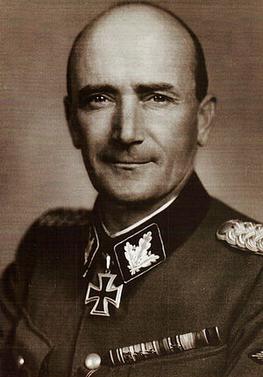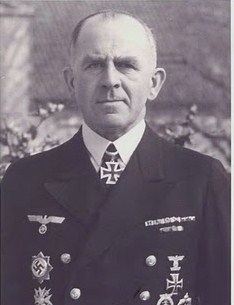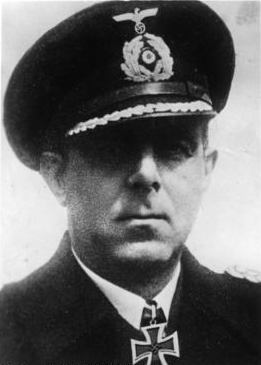
Fritz von Scholz was a high-ranking member of the Nazi Waffen-SS during World War II and a recipient of the Knight's Cross of the Iron Cross with Oak Leaves and Swords of Nazi Germany.

Otto Ciliax was a German naval officer who served in the navies of the German Empire, the Weimar Republic and Nazi Germany. As an admiral during World War II, he commanded the German battleships. He was a recipient of the Knight's Cross of the Iron Cross.

Hellmuth Guido Alexander Heye was a German admiral in World War II and politician in post-war Germany. He was a recipient of the Knight's Cross of the Iron Cross of Nazi Germany.

Fritz Frauenheim was a German U-boat commander of the Second World War. From September 1939 until retiring from front line service in December 1940, he sank 19 ships for a total of 78,853 gross register tons (GRT), and damaged two others. He was a recipient of the Knight's Cross of the Iron Cross of Nazi Germany.
Günter Hessler was a German naval officer during World War II. He commanded the Type IXB U-boat U-107, sinking twenty-one ships on three patrols, totalling 118,822 GRT of Allied shipping. Hessler was a recipient of the Knight's Cross of the Iron Cross and was commissioned after the war to write an account of the U-boat war by the British Ministry of Defence.
Rolf Thomsen was a U-boat commander in the Kriegsmarine of Nazi Germany during World War II and later served with the Bundesmarine. He received the Knight's Cross of the Iron Cross with Oak Leaves for his command of the German submarine U-1202.

August Thiele was an admiral during World War II and commander of the heavy cruiser Lützow. He was awarded the Knight's Cross of the Iron Cross with Oak Leaves.

Rolf Hans Wilhelm Karl Carls was a high-ranking German admiral and deputy to Kriegsmarine commander-in-chief Erich Raeder during much of World War II. Carls served as Flottenchef, the navy's highest ranking administrative officer, and was a member of the Oberkommando der Marine. He was instrumental in planning German naval operations during Operation Weserübung – the invasion of Denmark and Norway. When Raeder resigned as head of the navy in early 1943, he suggested Carls as a candidate to succeed him. After Adolf Hitler appointed Admiral Karl Donitz to succeed Raeder, Carls was discharged from the navy. A recipient of the Knight's Cross of the Iron Cross, he was killed in a British air raid on the town of Bad Oldesloe on 24 April 1945.

Kurt Fricke was an Admiral with the Kriegsmarine (navy) of Nazi Germany during World War II and a recipient of the Knight's Cross of the Iron Cross.

Günter Kuhnke was a German submarine commander during World War II and later a Konteradmiral with the Bundesmarine, West Germany's navy. He was a recipient of the Knight's Cross of the Iron Cross of Nazi Germany.

Kurt-Caesar Hoffmann was a senior naval commander in the German Navy (Kriegsmarine) during World War II, who commanded the battleship Scharnhorst. He was a recipient of the Knight's Cross of the Iron Cross.

Hubert Schmundt was a German admiral during World War II. He was a recipient of the Knight's Cross of the Iron Cross of Nazi Germany.

Otto von Schrader was a German admiral during World War II and a recipient of the Knight's Cross of the Iron Cross of Nazi Germany. As a U-boat commander during World War I, he was credited with the sinking of 57 ships for a total of 54,663 gross register tons (GRT), a further 6 ships damaged for a total of 52,333 GRT, including SS Justicia, and one ship of 336 GRT taken as a prize. Schrader was taken prisoner of war in Norway at the end of World War II. He committed suicide in Norwegian captivity on 19 July 1945.
Hermann Lukas Plocher was a German general during World War II. He was a recipient of the Knight's Cross of the Iron Cross with Oak Leaves of Nazi Germany.
Friedrich Sixt was a German general during World War II who commanded several divisions. He was a recipient of the Knight's Cross of the Iron Cross with Oak Leaves of Nazi Germany.
Werner Otto Sanne was a German general (Generalleutnant) in the Wehrmacht during World War II who commanded several divisions. He was a recipient of the Knight's Cross of the Iron Cross of Nazi Germany.
Hans Hahne was a German officer in the Wehrmacht during World War II who commanded the 197th Infantry Division. He was a recipient of the Knight's Cross of the Iron Cross of Nazi Germany.
Johann Ludwig Müller was a German general in the Wehrmacht during World War II, and a recipient of the Knight's Cross of the Iron Cross with Oak Leaves of Nazi Germany.

Joachim von Siegroth was a general in the Wehrmacht of Nazi Germany during World War II. He was a recipient of the Knight's Cross of the Iron Cross. Siegroth was listed as missing in action during the Battle of Halbe in May 1945.












